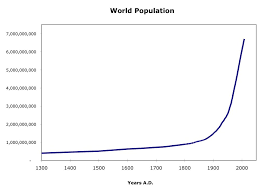Population. How many people live on Earth. With Africa’s population rising and developed countries beginning to fall, I have been wondering “what is the history of our population demographics as a species?” Well, let me brake it down for you: for almost all of human history, there have been less than 1 million people on this planet.

Sorry, this one is only from 1300. If you just imagine it way more scrunched up, then you can get a sense of how low the population has been up till the last few centuries. Anyway, for the first 130,000 years, anatomically (physically) modern humans had a stable population of under 1 million, sharing the planet with our cousin species with similar populations. Then, everything changed. And it was all because of one supervolcano: Toba. Lake Toba is a dormant caldera, that 70,000 years ago, erupted, leading to a near extinction and an ice age. Only the smartest survived, leading to a quantum leap in thinking. This led to a boost in population, over 2 million, allowing us to leave Africa and colonize the world. With our numbers, we spread across and led to the extinction of our cousin species. Then, with our advanced thinky parts, we came up with one very important thing: agriculture. This led to a boost (over 4 million), but led to malnutrition, decline in maximum age, and rigid social structures. But slowly, the population rose, and by 4,000 B.C.E., we had reached 30 million ( larger than most cities today). As new empires rose, like Rome,Persia, and China, we hit 180 million by year 1 ( I am using the Gregorian calendar). Our population grew for 1300 years until 1346, when the Black Death came. Also known as the Second Pandemic of Plague, this knocked out 1/3 of Europe’s population, and 1/10 of the entire world’s. We recovered, and we began to soar with improvements with medicine, sanitation, and technology. With the beginning of the Industrial Revolution in 1800, we reached 1 billion people. In 1920, we reached 2 billion. In the 1950s and 60s, China reached a population of 1 billion, the first country to ever do so. In 2000, we hit 6 billion, and the year after that, India became the second country to reach 1 billion. As of now, in 2023 we hit a population of 8 billion, and India has surpassed China as the most populated country. A few predictions for the future: (take them with a grain of salt). In 2100: Lagos, Nigeria, will have a population of over 80 million, replacing Tokyo as the most populous city in the world.Nigeria, as a whole will have a population of 520 million people. Many African countries, like the DRC,Eitheopia,Tanzania, and Egypt, will join the top 10 most populous countries list, while countries like Mexico, Brazil, and Russia will have their populations fall and have to leave the list. China’s population, alongside many Asian countries, will halve and may nearly be replaced by Nigeria. As a whole, our species’s population will stabilize between 9-12 billion people, and a good chunk of those may be living off world.Past 2100: If humanity decides to colonize the galaxy, our population will explode into the trillions, with all those resources. We will have to invent super fast transportation if we don’t want to splinter into multiple species.To get there, we need to respect each other and our planet, solve problems together, and not be jerks (and build colonization ships and stasis pods to travel across the galaxy).